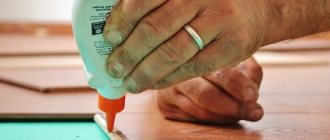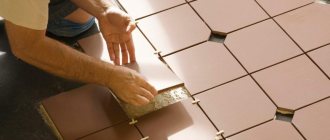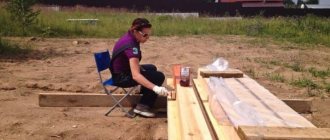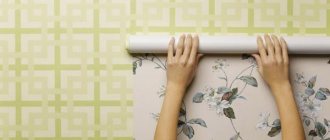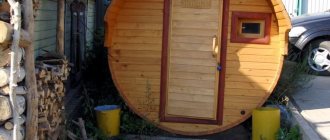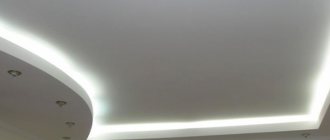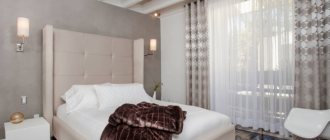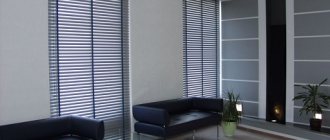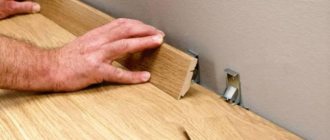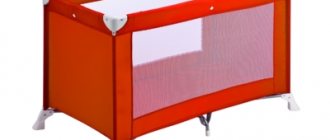Polyethylene material welding machine
It is very convenient to use a special welding machine to join film sheets, and welding can be completed in the shortest possible time. The device that welds greenhouse film is characterized by a fairly simple operating principle. A standard engine drives two wheels through a gearbox. Using a special tripod, a wedge heated to certain temperatures is inserted between the film sheets.
The result of welding using such a device is the formation of a double seam with a strength of at least eighty percent. Welding occurs automatically, and manual actions are necessary solely to change the temperature regime of the wedge and the speed of movement of the film web.
Most often, such a device is used in the industrial sector, but it is possible to use it for personal purposes. The manual type of such a device is a type of industrial hair dryer, but has less weight.
Welding
This method is used most often because it is considered the least expensive, but at the same time very high quality and durable.
Important: you must carry out the work with extreme caution, because there is a risk of not only spoiling the material itself, but also getting burned
The most commonly used method is bonding with plates. To do this, place the two edges of the polyethylene sheet that need to be glued on top of each other between the metal plates. The edges should protrude slightly. Gently press the plates and run the soldering iron along the very edge of the polyethylene. In this case, plates are necessary to ensure that the film simply does not curl under the influence of high temperature.
If you don't have a soldering iron, you will need an iron. Place the pieces of fabric to be glued slightly overlapping (1 cm). Lay strips of cotton fabric under the reverse side of the polyethylene and on it. After this, run the iron, heated to maximum temperature, over the fabric from above.
There are a large number of different glues for plastic available in stores. However, keep in mind that the vast majority of compounds are not suitable for polyethylene. But do not discard this method - to glue polyethylene, you can use standard glue for plastic after careful preparation of the material.
In order to make the surface of polyethylene more active for adhesion, you will need chromic anhydride or chromium. Such products are sold in specialized chemical stores. If you have chemist friends, you can ask them for the composition. Chrome gently acts on the surface of polyethylene, making it receptive to glue.
Anhydride or chromium should be applied to the film, and only then the usual BF-2 glue, which is sold in every store. Such a simple method of gluing polyethylene would become very popular if the necessary chromium-based substances were easier to obtain.
Pasting walls with oilcloth
How to glue oilcloth to walls? There's nothing complicated about it.
Preparing the base
Please note that if a repeating pattern is applied to the oilcloth, then the coating should be purchased with a 10% margin. After all, the drawing will have to be adjusted.
- Preparing the base . You need to completely remove the old finish from it - paint, whitewash, wallpaper, etc. Then the walls are cleaned of dust and dirt. After this, it is advisable to cover them with antiseptic primer.
- Purchase of materials . Buy the required amount of oilcloth and adhesive from a hardware store. If the finish is not self-adhesive, then Bustilat or PVA are best suited for fixing it.
Old paint from the walls must be removed.
Wall decoration in 6 steps
| Teflon oilcloths |
| Silicone coating |
| Oil coating |
| Photo | Instructions |
| Step 1. Preparing the glue |
This is done according to the instructions on its packaging.
PVA and Bustilat are diluted with clean cold water to the desired consistency.
Thanks to this, their excess can be easily removed with a damp sponge or cloth.
It is cut with scissors into panels of the required size.
The most famous manufacturer of table film in the world is the Japanese company Meiwa. They provide clear, colored, matte overlays to the market. , both in large rolls and in standard tabletop sizes.
In terms of their positive qualities, glass table films from domestic manufacturers do not lag behind Japanese ones. Decosave and Modern companies produce both transparent overlays and tablecloths in various shades and patterns, which allows you to match them to any interior.
“Ofiston” is considered the best company in Belarus that produces thick transparent film for the table. Their transparent tablecloths have gained popularity among customers, which indicates the high quality of the product.
Everyone has probably heard about the Swiss company Ikea. The quality of this company's products is evidenced by many positive reviews. The models of table films that are most quickly leaving the shelves of the Ikea store are the transparent “Preuss” and “Skrutt”.
The following companies are also successful in selling silicone tablecloths:
- Durable;
- Esselte;
- Leitz.
Oilcloth for walls
The most popular solution for using oilcloth is covering a dining table.
Previously, oilcloths were sold on a cardboard base, on which a layer of polyvinyl chloride (PVC) was applied to give strength. It is worth noting that such oilcloths were of rather poor quality: flimsy, had a strong, nasty smell, and over time the designs on them wore off.
With the introduction of modern new technologies, oilcloths have emerged using synthetic and polyester varnish compositions, giving the material brightness, density, lightness, and wear resistance. Modern oilcloth is more of a fabric, which is why it looks quite interesting and beautiful.
Which oilcloth to choose for the kitchen table
To choose oilcloth for the kitchen table, you need to consider the following features:
- the oilcloth must be durable, currently they produce oilcloths that cannot be cut with a knife or melted with hot materials;
- be resistant to cracking and deformation, which is ensured by a special varnish coating;
- Oilcloth for the kitchen should be viscous, many modern oilcloths are made with a special adhesive surface, and the tablecloth sticks closely to the table; such oilcloths are of poor quality.
- When working in the kitchen, the oilcloth must withstand the humidity of the room; such oilcloths can be called PVC oilcloths.
For the production of kitchen oilcloths, fabric, paper and non-woven fabric bases are used. The highest quality oilcloth is based on non-woven fabric.
There are also oilcloths made in an openwork style. They are very beautiful and elegant, but inconvenient for daily use; they are best used for festive purposes.
How to glue it correctly
First of all, you need to calculate how much material you will need. To do this, you need to take measurements of the area of the kitchen where the oilcloth will be glued. To do this, you need to know the length, width and height of the room. Further:
- The surface on which the oilcloth will be glued should be thoroughly cleaned of the old coating. This could be paint or wallpaper. You also need to thoroughly wash the area to remove dust and dirt. If you used water, then dry the walls well after that.
- When gluing this material, you should use PVA glue or Bustilat. They dilute well with water and do not leave stains or streaks. Remains of this glue can be easily wiped off with a damp sponge.
- The oilcloth needs to be cut into strips that are convenient for you; if there is a pattern, “fit it.”
- The glue should be applied to the strips carefully, and the oilcloth should be completely covered with glue without gaps, because bubbles may subsequently form. For a better effect, you can apply the adhesive composition to the wall. This is done in this way: coat the wall with a brush or roller, let it dry, then apply another layer of glue.
- We glue the strip to the wall, smooth the canvas from the center to the edges, so air does not accumulate under the oilcloth.
- We glue every second strip of oilcloth with a slight overlap on the first one.
- It is best to start gluing from the corner, so the joints will stick well.
- If the oilcloth is slightly swollen during pasting, you should lightly cut the oilcloth, or pierce it with a needle, release the air and gently smooth it with a cloth.
- After the glue has dried, the oilcloth must be washed with soapy water. If any glue residue remains or there are streaks, rinse again.
- In order to maintain the shine for a long time, experts recommend occasionally wiping the surface of the oilcloth with a mixture of vinegar and milk, which are diluted in equal quantities.
If you want to completely update your kitchen interior, then oilcloth can also be used to cover furniture surfaces. It can be used to cover a closet, table, cabinets and even a refrigerator. This will give your kitchen a new and fresh look. This method is the cheapest for updating the interior. There are no particular difficulties when covering furniture with film, because it lays flat on any type of surface.
Good luck and enjoy your interior renovation!
Flaws
Bustilat does not have any particular disadvantages in its field of application. May be inferior to some modern analogues in terms of durability.
To summarize, we can say that Bustilat is a reliable and inexpensive adhesive ideal for gluing wallpaper, linoleum and many other materials used in interior decoration.
When it comes to renovating a kitchen, the practicality of the materials with which it is planned to decorate the room comes to the fore. Today, the building materials market is ready to offer a lot of options that meet both the visual and utilitarian wishes of the buyer. True, many of these solutions come at a considerable price, which not everyone is willing to pay, so today’s article we will devote to oilcloth - an inexpensive, practical and very aesthetic material. How to glue oilcloth to the wall, what tools you will need for this and how to ultimately glue it to the wall - read below.
Tool preparation
If you have already finally decided that oilcloth will be used as a finishing material for the walls in the kitchen, then for DIY repairs you will need the following set of tools:
- Cutter - it is necessary for the formation of separate panels of film, which will subsequently be glued;
- A pencil, pen or other writing object - everything is clear here, you will first need to apply markings, according to which the walls in the kitchen will be covered;
- A measuring tool, for example, a tape measure or a ruler - the purpose is just as obvious;
- A hairdryer, preferably an industrial one - with its help you will treat the surface of the film with warm air or warm up the puncture sites of bubbles that inevitably arise during fastening;
- Use a spatula or squeegee to smooth out the film so that it is evenly pressed against the wall.
Surface and material preparation
- The first step, as when using any other finishing material, is to calculate the required amount of oilcloth. Having measurements of the length, width and height of the room or specific area where repairs are planned, it is easy to calculate the area and understand the required quantity of the product. Do not forget that if the oilcloth has a pattern, then it is necessary to take a certain supply of material, about ten percent, in order to subsequently be able to adjust the pattern.
- The success of repair work directly depends on the quality of the preparatory work done, so take your time and carefully free the walls from the previous coating, as well as various deposits of dirt and dust. We advise you to wash the bare walls with a solution of water and soda, and then dry them thoroughly.
- Now is the time to go to the store and buy the oilcloth you like, as well as glue - it is recommended to use PVA, Bustilat. These types of glue are diluted with water, and therefore there are no stains left when the oilcloth dries. Remember that the glue must be fresh, try not to come across a fake.
Pasting technology
- It's time to prepare the material for work. First you need to prepare the glue following the instructions. The material, in turn, is cut into strips that match the ornament. The glue must be applied evenly to the oilcloth; a brush and roller are used for this; inattention to this procedure can lead to the formation of bubbles. Now the resulting strip of oilcloth can be glued to the wall; this is done in the same way as in the case of wallpaper - pressing from the center to the edges and smoothing the material, thereby expelling the air.
- Each subsequent canvas must be glued with a slight overlap on the previous one in order to maintain an even pattern.
- In the case when oilcloth on kitchen walls is done for whitewashing, the wall must first be treated with glue, otherwise the whitewash may come off the plaster and the repair will be ruined.
- The pasting process begins from the corner of the room. There is a problem with gluing the joints, so it is recommended to put paper strips soaked in wallpaper glue on top of them; when the work dries, they can be moistened and removed. The top of the covering must be secured with a pre-selected border.
- If during the process it was not possible to avoid bubbles, then they should be cut and carefully smoothed after the air has escaped from them. There is no need to worry if defects due to air ingress do not occur when using oilcloth for walls - this material is easy to work with and any defect can be eliminated in a matter of minutes.
Oilcloth on the wall for the kitchen
When renovating the kitchen, everyone thinks that everything should be simple and practical, because this room has always been the most popular place in every apartment and the pride of the owner.
Modern building materials can satisfy the needs of any person, even the most fastidious. But, unfortunately, not everyone has the means to cover their kitchen with expensive materials. Therefore, oilcloth on the wall in this case is the best option, because it has a beautiful appearance and is quite cheap. The kitchen, most of all, differs from other rooms in its practicality, since the risk of contamination is highest here. Therefore, oilcloth would be most appropriate here, since after each cleaning it looks like new.
Of course, there is now a large selection of these products on the market, but how to choose high-quality, not expensive material, but at the same time, it looks beautiful and stylish? Let's try to find out, because like every finishing material, oilcloth has its own advantages and disadvantages.
The main advantages of oilcloth
Fabric tablecloths are impractical for use on the kitchen table, so oilcloth is the best option for the kitchen.
- This type of coating is resistant to mechanical stress, there is no damage from hot dishes, it is an environmentally friendly material.
- In addition, oilcloth can hide an old countertop and give new life to an unsightly kitchen table.
- Also, thanks to the wide range, you can choose absolutely any pattern and color, this will help you choose oilcloth for any interior.
- The cost of oilcloth is low; after it wears out, you can buy another one, and the table surface will be preserved in its original form.
- Oilcloth does not absorb water, is easy to clean, and has an attractive appearance.
Note! These are the characteristics of expensive tablecloths made of oilcloth, fabric and non-woven.
Procedure for installing oilcloth
First of all, it is advisable to calculate the required amount of material. To do this, it would be correct to take measurements of the room or kitchen area, depending on your goals. Measure the length, width and height and subtract the area of the room using the formula. You can also give the dimensions to the seller and he will calculate the area of your premises. And there is no need to even say that the coating with a pattern must be purchased with a reserve, because you will be gluing the oilcloth with a selection. Next you need to prepare your walls. You need to remove the old coating (paint, wallpaper, etc.), clean it from dirt and dust, wash off the dirt, and so on. It goes without saying that at the end of the procedure the walls must be thoroughly dried. Purchase oilcloth of the required size and quantity from a hardware store, and don’t forget about glue. Of course, we all know very well that PVA glue and Bustilat are used to glue the coating. Please note that they are diluted with water, so they do not leave stains when they dry. Everyone knows that excess glue can simply be removed with an ordinary rag. Do not use expired glue, check the date of manufacture of the glue with the date of gluing. According to the description on the package, you need to prepare glue. The material is cut into the required strips, adjusted according to the ornament and design. And it doesn’t even need to be said that the strips are carefully coated with glue - with a brush or roller, so that bubbles do not appear later. Undoubtedly, it is worth mentioning that the glue is first applied to the wall, allowed to dry slightly and again smeared with a second layer. The strip is glued to the surface, proceeding in the same way as with wallpaper: press the canvas from the center to the edges, smoothing the oilcloth over the surface, thereby expelling the air. The next sheet of oilcloth must be glued with a slight overlap. The joints are painstakingly rolled with a special wallpaper barrel so that they are not visible. If the pasting is done on chalk whitewash, then you should first treat the wall with glue so that when the whitewash dries, it does not move away from the plaster. Better yet, before gluing the oilcloth, wash off the whitewash and prime the walls. It is advisable to start gluing the oilcloth from the corner of the room, moving clockwise. After you have glued the sheets, you can glue the paper strips at the joints of the sheets with regular glue, and after they dry, wet them and peel them off
This is to seal your joining seams. If after you have finished the work, air bubbles suddenly form, then you need to carefully pierce them with a syringe, let a little glue in there and smooth them out.
Information about oilcloth
Various materials are used to make oilcloth, giving it strength and good resistance to mechanical damage. The components that make up the oilcloth ensure excellent environmental friendliness of the coating.
Positive aspects of coating
Oilcloth does not absorb moisture. Therefore, it can be safely used to decorate walls in the bathroom, kitchen and many other utility rooms.
Possessing heat resistance, oilcloth can be used to cover the kitchen work area, as a so-called kitchen apron.
The material does not absorb fats and various dirt. It is easy to remove dirt using a soap solution.
The low price of oilcloth allows you to replace wall cladding with a new material.
A huge range of coatings allows you to match it to any interior style and become a real decoration of the room design.
The disadvantage of oilcloth is the risk of harmful microorganisms: mold, mildew.
Oilcloth for walls
The most popular use of the material is as a dining table cover.
More recently, oilcloths have been on sale with a paper or fabric backing, on which a layer of polyvinyl chloride (PVC) was applied to ensure strength. These types of oilcloth were not very durable, had a strong chemical smell, and over time the paint rubbed off from the design.
With the use of modern new technologies, materials using synthetic and polyester varnishes have appeared, giving oilcloth brightness, thinness, lightness, and wear resistance. Modern oilcloth has become similar to fabric, and this property allows it to be used for unusual wall decoration.
Application area
- Oilcloth with its fancy ornament or pattern and beautiful design can compete with wallpaper, especially in rooms with high humidity: bathroom, kitchen.
- The coating can be used to decorate furniture: finishing shelves, table surfaces and using unusual zippers in furniture instead of doors.
Oilcloth gluing technology
You need to know about the features of pasting with this coating even before you decide to use oilcloth for wall decoration.
Work order
- It should. To do this, take measurements of the room or kitchen apron. Knowing the length, width, height of the room, you can easily calculate the surface area without taking into account window and door openings and can determine the length of the oilcloth. Remember that if the coating has a pattern, then you need to buy it with a reserve to adjust the pattern.
- Now you should prepare the surface of the walls well. Completely remove the old coating (paint, wallpaper, etc.), clean from dirt and dust, if necessary, wash with the prepared solution: 3 tbsp per liter of water. l. baking soda. After the procedure, the walls need to be thoroughly dried.
- Purchase the estimated amount of oilcloth and glue in the store. To glue the coating, PVA glue and Bustilat are used. They are diluted with water, so they do not leave stains after drying. Excess glue can be easily removed with a damp cloth. Be sure to check the release date - the glue must be fresh.
- Prepare glue according to instructions.
- The material is cut into the required strips, adjusted according to the ornament and design. The strips are carefully coated with glue as evenly as possible, without missing a single area, using a brush or roller, otherwise there will be bubbles. The glue is also applied to the wall, allowed to dry a little and then smeared again with the next layer. The strip is glued to the surface, proceeding in the same way as with wallpaper: press the canvas from the center to the edges, smoothing the oilcloth over the surface, expelling the air.
- The next canvas is glued with a slight overlap on the first, matching the pattern. The joints are carefully rolled so that they are not visible.
- If pasting is done on chalk whitewash, then you should first treat the wall with glue so that when the whitewash dries, it does not come away from the plaster.
- You should start gluing from the corner. To ensure that the joints stick well, paper strips coated with wallpaper glue are glued on top of them. After the oilcloth has completely dried, the strips are moistened and removed. The top of the covering is secured with a suitable border.
- If bubbles form during gluing, carefully cut them with a sharp knife, release the air and smooth them out.
Operation and care
- After drying, the surface with the oilcloth should be washed with soapy water at room temperature and wiped dry. Repeat the procedure as it becomes dirty.
- Do not use aggressive detergents containing acids and alkalis to extend the life of the material.
- To maintain the brightness and color of the coating, it is recommended to periodically wipe them with a mixture of milk and vinegar, diluted in equal proportions.
Now you can imagine how to glue oilcloth to the wall
. With its help you can get an extraordinary interior for your bathroom or kitchen.
Reading time ≈ 3 minutes
Bustilate is a grayish-white synthetic glue with a consistency similar to sour cream. For half a century it has been used for gluing wallpaper, various types of linoleum, chipboard, tiles and other decorative components. The use of Bustilat is possible only in interior work.
Manufacturers and prices
Let's find out which of the manufacturers today offers us the best selection of transparent kitchen tablecloths at reasonable prices.
NIKLEN
The Canadian manufacturer offers the most elegant models made of PVC. The work is so delicate that from a distance a confident impression of natural lace is created. Ornaments are traditional: floral, plant. A product 110x140 cm rectangular in shape will cost 352 rubles.
Agness
This Chinese trading and manufacturing brand offers high-quality polyester products. The models are real works of art - beautiful, but at the same time practical. The cost of a transparent lace product 85x85 cm is 1,776 rubles.
Gray Textile
The Chinese brand offers elegant models of PVC lace weaving. The cost of a product with a floral pattern 85x85 cm is 780 rubles.
If you want to purchase a strict, practical model without lace or other decor, suitable for everyday use and fitting into modern, laconic interiors, opt for Russian products with a strict rectangular shape. These tablecloths are a smooth, dense PVC film that protects the tabletop with an ideal transparent layer. Or opt for a set: tablecloth and chair covers in the same color scheme.
Such products are very inexpensive. For example, a tablecloth measuring 180x120 cm will cost only 57 rubles. Photos of various tablecloths for the table can be seen here.
Variety of assortment
The market today offers a huge variety of coverings for the dining table - these include napkins, oilcloths, and tablecloths. They come in completely different shapes - round, rectangular, different sizes, and a variety of colors. Therefore, it will not be difficult to find a model to suit your taste, suitable for almost any interior. China is the leader among manufacturers, but products from Russia and Western countries are sufficiently represented.
It’s quite easy to choose the color and design style of the tablecloth you’re interested in. It is much more difficult to find environmentally friendly and high-quality material. Therefore, it is recommended to focus on this when choosing. It should be taken into account that very cheap oilcloth from China will not be of high quality and environmentally friendly. For those who do not like tablecloths, there are napkins that can be used during meals for each person. They are also easy to clean and protect the countertop from temperature changes and dirt.
Related links: Can I use drywall to finish a bathroom?
Advantages and disadvantages of the material
This type of finishing has many advantages. One of them is easy installation. This type of lining can be changed quite quickly if the old oilcloth in the bathroom has become dilapidated.
This material is available in a wide range. Today you can buy films of any color, with different ornaments and patterns. This allows you to select finishes for any design and style of the bathroom.
Covering bathroom walls with oilcloth significantly saves the family budget. This is an inexpensive material that is not afraid of moisture. Consequently, dampness and mold will not appear in the bathroom.
This type of finishing can be used for other interior elements. For example, you can decorate the facades of an old cabinet or a section of the wall above the sink in the kitchen with self-adhesive film. In addition to its water-repellent properties, this material can withstand significant temperature changes.
They produce film without a backing, on a fabric or paper base, foamed or embossed.
Oilcloth with backing
At the same time, oilcloth for the bathroom, the design photos of which in our gallery will help you make the right choice, also has some disadvantages. Before covering the walls with polyvinyl chloride film, the facing surface must be perfectly smooth. Only in this case will the oilcloth lie flat and last a long time. It is necessary to remove all irregularities and defects in the coating and carefully plaster the wall.
Plastering bathroom walls
In general, oilcloth finish is suitable for almost any substrate. It can be applied to glass, wood, plywood, metal, mirror, plaster surfaces and even tiles.
If you have chosen oilcloth for the bathroom walls as a finishing material, you should stock up on the necessary tools before carrying out the repair. You will need:
- special cutter for preparing film panels;
- pencil or ballpoint pen for marking;
- measuring tape or ruler;
- hair dryer (household or industrial); scissors;
- a felt spatula or squeegee that allows you to smooth out the facing material.
When applying self-adhesive film, a hairdryer is needed to treat surfaces, corners and joints with warm air. They also need to warm up the puncture sites of air bubbles that may appear during the installation of the oilcloth.
Oilcloth on the table. How to choose?
What should the things around us be like in everyday life? First of all, easy to use and practical. Starched embroidered tablecloths look great, of course, but not every housewife would dare to cover the kitchen table with them. Oilcloth is another matter.
Oilcloth tablecloths have long become indispensable in our kitchens. A beautiful design gives the room an elegant look, and the ability to quickly and easily remove dirt eliminates additional hassle.
However, the scope of use of oilcloth is not limited to the kitchen table; it is used for pasting walls, as a waterproof covering in medicine or for caring for babies.
Oilcloth on the kitchen table
Variety of assortment
Buying oilcloth to suit your taste will not be difficult: the market offers many options - different compositions, strength, colors and, of course, cost. The geography of manufacturers is also very wide - China, Japan, European countries. The domestic industry also offers a worthy choice.
Thanks to designer imagination, new colors and patterns appear, and scientists are working to make the coating more environmentally friendly and resistant to mechanical damage.
Types of oilcloth and their characteristics
The basis for oilcloth is usually fabric, paper or non-woven materials. A layer of polymer (most often polyvinyl chloride) is applied on top of the base. This material is not damaged by many chemicals, is reliable and can last quite a long time.
The highest quality oilcloths are fabric-based, non-woven is considered more durable and wear-resistant, and paper-based oilcloth is the least durable, which is why its price is noticeably lower.
Table oilcloth is in greatest demand today. It is used not only as tablecloths, but also as a material for making napkins and aprons.
Variety of oilcloth colors
Choosing oilcloth
The color of the oilcloth should match the color of the wallpaper or curtains. In the cold season, designers advise paying attention to bright colors and summer “warming” designs, and in the warm season, to prints in cold tones that will help create a feeling of freshness and coolness.
Care instructions
Buying oilcloth that will fit well into the interior is only half the battle. To maintain its integrity and brightness of colors, you must follow simple operating rules:
• do not use alkalis and acids for cleaning, which can damage the surface;
• wash with warm soapy water and wipe dry;
• if the coating is not heat-resistant, do not place hot dishes on it.
You can choose oilcloth in our catalog
Colored oilcloth for the bathroom
In Soviet times, the choice of building materials and the shortage of furniture often led to the fact that many housewives did not allow many housewives to realize their creative ideas in their apartments. Despite this, the owners created a beautiful design and competently equipped their home.
In modern times, everything has changed for the better; manufacturers offer a wide variety of materials to suit every taste, color and budget. On the market you can find a huge assortment of self-adhesive oilcloth; of course, this material is inferior in quality to ceramic tiles. But if you waterproof it correctly and glue the film to the wall, then such a coating will reliably protect the bathroom from moisture.
How to choose
When choosing a color or pattern for kitchen oilcloth, you need to rely on the overall design of the kitchen. Oilcloth will look ridiculous if you pick it up as a separate spot on the kitchen table; the shade of the oilcloth should be combined with other elements of the kitchen interior.
If light colors are chosen to decorate the kitchen, then the oilcloth should be in cool colors. If the kitchen decoration is chosen in a warm color, then the oilcloth can be chosen with an orange, yellow or green tint.
The quality of the material will also be indicated by the price of the product. The higher the quality, the more expensive the product will be. When choosing inexpensive oilcloths, you may end up with unsafe oilcloths containing polystyrene additives. Such oilcloths can emit an unpleasant odor that does not disappear for a long time.
Therefore, look at the price, choose quality and have a good time every day.
Vinyl and silicone tablecloths
Vinyl is a practical, easy to use and care for modern material that has an attractive appearance. Any dirt can be removed in a matter of seconds with a damp cloth or sponge. Today they produce models that imitate fabric and look very elegant.
Vinyl practically does not wrinkle, but if severe dents, creases and folds form, you can use an iron. Iron a vinyl tablecloth using a warm iron through a damp cloth. Do not put pressure on the material or stay in one area for too long.
Silicone is used to protect the table from scratches and dirt. Silicone products are a film that is laid directly on furniture or on kitchen napkins, lace or fabric tablecloth. Silicone is characterized by easy use and care, practicality and resistance to various factors, durability and elasticity.
The silicone tablecloth does not slip or slide, does not rustle or slide. It does not wrinkle and lies flat on the table. You just need to carefully place the film on top of the table and smooth it out with your hands. If you want to stick the tablecloth on a glossy, glass, lacquered or other table as a protective film, mix water with two drops of dishwashing detergent.
Add the resulting product to a spray bottle and spray on the tablecloth and table. Place the film on the surface and level it, smooth the material with a cloth to remove water. After three to four weeks, trim the material according to the parameters of the table.
Materials and their characteristics
When choosing a product, you should pay attention first of all to the material. Most often when making tablecloths, the following are used:
- Natural materials – paper, cotton, linen;
- Synthetic materials – polyester, polyethylene, polyvinyl chloride;
- Mixed fabrics.
Oilcloths on paper are the most fragile. Ordinary table oilcloth is usually quite durable and inexpensive, but the colors wear off quite quickly and it requires regular replacement. Tablecloths made from natural fabrics have a number of advantages: they are usually beautiful, durable and environmentally friendly. The downside is that they are easily soiled and require frequent washing and ironing. Tablecloths made from mixed fabrics are usually more practical, no less beautiful and do not require ironing.
Related links: 7 home management tips that will make your life easier
Non-woven oilcloths are the most durable and practical. Products made from polyvinyl chloride are popular today; they also have many advantages: practicality - they practically do not absorb dirt, are easy to wipe and clean, and reliably protect the table surface. There are very beautiful, openwork options, almost indistinguishable in appearance from an expensive tablecloth made from natural materials, but more practical.
The main disadvantage of such oilcloths is their lack of environmental friendliness. Some products even emit an unpleasant chemical odor, and you should absolutely not use them - this can be harmful to your health. A properly selected oilcloth or tablecloth will extend the life of the kitchen table. This is especially true for glass models that are fashionable today. Additionally, it can enliven and decorate the kitchen interior.
Tablecloth made of polyester and PVC
Polyester is the most common and affordable material for kitchen tablecloths. It is easy and quick to wash, does not fade and has a low price, but does not wrinkle much. They make completely polyester products and polyester tablecloths based on cotton.
Both options cannot be boiled and it is not recommended to iron even with minimal heat from an iron or hair dryer. Such materials melt under the influence of high temperatures, so it is better to use smoothing methods without the use of these devices. Use weights or heavy objects.
Polyvinyl chloride is the second most popular material due to its practicality and durability. If creases or unevenness occur on a PVC tablecloth, carefully iron it with minimal heat using light and smooth movements. Iron only through a damp cloth! For thin material it is convenient to use a hair dryer.
Products made of polyester and PVC do not like washing and are considered disposable. The material should be periodically wiped with a damp sponge or cloth, and then wiped dry. Then the tablecloth will last a long time. But when it loses its attractive appearance, it is better to replace the product with a new one rather than resort to washing.
In exceptional cases, you can wash oilcloth, but only by hand and at a temperature not exceeding 40 degrees. These tablecloths are ideal for garden furniture on the terrace, in the bathhouse or in the country house.
Advantages and disadvantages
The use of Bustilat glue has both its advantages and disadvantages. He is:
- practical;
- accessible;
- reliable;
- has low consumption;
- does not contain harmful substances;
- has a low price.
It can be used for almost all interior work. And since the composition does not set immediately, you can have time to correct some shortcomings.
Bustilat has one minus. There are analogues that are more durable, but this is not a reason to refuse it.
If you want to carry out high-quality repairs and save money, then Bustilat glue will help. It meets all the basic requirements of GOST. And due to its effectiveness, it can be used instead of expensive foreign-made products.
Reading time ≈ 3 minutes
Bustilate is a grayish-white synthetic glue with a consistency similar to sour cream. For half a century it has been used for gluing wallpaper, various types of linoleum, chipboard, tiles and other decorative components. The use of Bustilat is possible only in interior work.
DIY apron for the kitchen.
Good day, dear visitors of the site rems-info.ru.
I want to tell you about a solution to a problem that almost everyone who moved into a new apartment with finishing from the developer has encountered. As a rule, in a modern new building, a protective wall apron in the working kitchen area (which protects walls and wallpaper from splashes of water, grease, etc.) is simply not provided. And if you are not going to make a new renovation in the near future and have already spent a lot on purchasing kitchen furniture, then I will tell you a simple, and most importantly inexpensive option for decorating a kitchen apron with your own hands, which will allow you to forget about this problem for a year or two. To do this you will need:
- Kitchen oilcloth. The one that is usually used to cover the table. We choose medium thickness, any color and shade or colorless - it’s just a matter of your taste. The standard width is 140 cm. The length depends on the size of the kitchen and the width of the desired apron. Prices for this product are reasonable and vary widely.
- Furniture stapler with staples. I already had a stapler, but it is better to purchase staples with a greater depth, for example 12-14 mm. The price for boxes of 1000 pieces is around 100-200 rubles.
- Scissors, stationery knife, measuring tape and other available tools.
- A little imagination.
So, let’s move on to decorating an apron in the kitchen from oilcloth with our own hands.
These were the usual nondescript walls in our kitchen.
We went to the store to get the necessary materials. The choice of oilcloths is huge.
Prices are approximately in this range.
I opted for a bright, kitchen-themed oilcloth.
It all depends on the color of the wallpaper and kitchen furniture. You can lay the same oilcloth on the table, then you will have two bright, well-combined accents.
In the same store we buy furniture staplers and staples.
We bring all this home and move on to the main lesson. You need to carefully measure the length and width of the piece of oilcloth you need. Keep in mind that you need to run along the wall behind the worktop in order to protect our wallpaper there too. Since oilcloth is a very easy-to-work material, you can easily measure the length, cut out sockets, switches and other elements. If the work area is corner, then simply wrap the oilcloth on another wall.
After we have measured and cut out the necessary sections, we begin to attach them to the wall with a furniture stapler.
This is quite difficult, since the walls are not made of wood, but of brick or concrete. It is better to use brute male power. We apply the oilcloth evenly, if you have cabinets hanging, then directly under them, but if the wall is not loaded with anything, then simply along an even line (you can even mark it with a pencil).
We continue in the same spirit with an interval of 10 - 15 centimeters.
When you have secured the oilcloth along the entire length of the working area, secure the joints and edges of the sections in the same way. Cut holes for sockets, switches and other elements that cannot be secured from above.
If you plan to have any shelves, holders, dryers, etc. in your work area, then we attach it all to our finished apron. Again, due to the fact that this is oilcloth, there will be no problems with drilling and screwing in screws.
In this photo you can clearly see how the socket is cut out, and the holders for all sorts of kitchen little things are already attached to the apron.
I advise you to make the protective apron higher above the kitchen stove, since in this area the walls get dirty the most - droplets of fat fly from a heated frying pan, steam from a boiling kettle settles.
This is how we quickly and cheaply made a kitchen apron with our own hands, giving it a bright accent in our kitchen in soothing colors.
As you can see, nothing complicated! A little time, a little expense, a little imagination and such a small but important problem has been solved. I hope your apron will serve you until major renovations! Good luck!
Pasting walls (floors) with oilcloth and fabric
It is possible to add zest when decorating a room using various methods, including pasting the surface with oilcloth or fabric (velvet or chintz). You can not paste over the entire surface of the walls of the room, but only a small part of it. Fastening of such materials is carried out using mastics, glue, paste, and also nails (rarely).
Before pasting with such materials, it is necessary to prepare the surface: seal the grooves in the wooden chopped walls with plaster lime-gypsum or gypsum-sand mortar, or seal them with slats, and then line the walls with plasterboard sheets. Fastening with nails . If chintz with an ornament or pattern is used, it is necessary to ensure their alignment when preparing the panels. Having cut the material into pieces of the required length, sew the panel to the size of the wall, in which holes are cut for windows and doors. First, the panel is attached at the top, near the ceiling, pulling it tightly. Nails are driven in at least every 25 cm. After this, the panel is fastened below, near the baseboards, making sure that the material is stretched without wrinkles near the window and door openings. It needs to be attached especially well in corners. Velvet is upholstered in the same way. Chintz and velvet can be nailed down, without sewing the panels together, in separate pieces, driving nails into the edges. The edges can be laid one under the other and the nails placed in one row; You can also nail the edges of each panel separately. Gluing . For this purpose, various glues and mastics are used, but the best is an ordinary paste made of flour or starch with the addition of 100-150 g of wood glue to it (per bucket of paste). Gluing on paste is convenient because if you need to remove chintz or velvet, you just need to moisten them with water, and as soon as the paste gets wet, they can be easily removed. It is not always possible to soften other types of adhesives and mastics. You can glue in large panels or individual panels, the latter are more convenient to use. You cannot smear the fabric like wallpaper: the paste will penetrate the front surface and when smoothed, it will become shiny. Therefore, the surface is covered with the prepared paste and allowed to dry until it is tack-free, that is, to a state where the fingers will still stick to it, but without the paste sticking to them. Place the fabric on this paste and smooth it well. The velvet is smoothed through paper or struck with a dry brush. Hands should always be clean and dry, without traces of paste. You cannot drive a nail into stone, brick, or concrete surfaces, but although it can be easily driven into plaster, it can also be removed very easily. Therefore, you should do this. Thin slats with a width of 20 mm are made and material is attached to their back side with thin nails, and then the slats with the material are attached to the wall. They are attached in the same way at the bottom. If the material is nailed to the face of the slats, it will not fit tightly to the wall. The slats are attached to the walls like this. First, holes are drilled or punched in the walls, wooden plugs are inserted into them so that they hold firmly, and nails are driven into them through the lath. Some strengthen the panels by hanging them on a strong thread. Near the corner, nails are driven into the wall from above and below. A thin, strong nylon thread (fishing line) is passed through the sewn cloth, pulled tightly, secured firmly to the nails and the material is straightened. This is how they fix the walls on all four sides. It is advisable to first carry out a test gluing by gluing a small piece of chintz onto cardboard or plywood. Pasting walls (ceilings) with oilcloth . Oilcloth is much easier to apply than chintz and velvet. Adhesives and other contaminants are easily removed from its front side. In practice, it is glued in the same way as linkcrust, but it is not soaked in water.
Oilcloth can be used to cover not only walls, but also floors. However, it is not recommended to cover the walls to their full height, but 1.5-1.7 m from the floor, as if arranging a panel. The oilcloth can either be glued or nailed.
Regular nails are used. The oilcloth is cut into sheets of the required length, hung on the walls, attached in several places with nails at the top and bottom. The top edges are covered with a layout, i.e. a strip no more than 30 mm wide.
It can be painted with oil or enamel paint or varnished. In order for the edges to fit tightly against one another, they have to be cut along a ruler. Oilcloth is glued to the floor using strong adhesives, mastics or pastes.
Pasting walls (floors) with oilcloth and fabric
Scope of application of Bustilat glue
It is easier to clarify where Bustilat cannot be used, since the characteristics of the composition are suitable for performing a large number of installation works.
Gluing heavy wallpaper, floor coverings, carpets.
For installation of borders, baseboards, tiles, linoleum that does not have a base.
Working with tiles, slopes, decorative panels.
In order to connect different types of materials: polymers, PVC, film, leather, leatherette, suede.
This is just a small list of possible uses of the product. Due to its high adhesion, glue is often used for finishing floors, walls and other surfaces.
Other gluing methods
You can glue greenhouse polyethylene in other ways.
- The use of xylene and trichlorethylene heated to a temperature of seventy degrees, as well as through acetic acid heated to thirty degrees with a concentration of 80%.
- The use of certain types of glue. The best option is to use BF-two or BF-4 glue. The bonded surfaces must be pre-treated with a solution of chromic anhydride with a concentration of 25%.
- It is advisable to glue the polyamide film using PK-5 glue, and the resulting joint should be ironed with an iron heated to fifty degrees.
- Using a special super glue designed for gluing polyethylene materials. Such adhesives appeared on the Russian market relatively recently, but many gardeners and gardeners have already appreciated the ease of use. The glue is completely odorless, and the strength of the resulting connection is quite sufficient for using such material as a covering for greenhouse structures.
Russian manufacturers produce several special devices that allow you to weld polyethylene at home. The most inexpensive and high-quality device for such work is the PP-40 series device. In terms of external indicators, such equipment resembles a traditional soldering iron with a slightly modernized tip.
Features of use
The packaging must be removed very carefully. The use of any sharp objects, especially scissors and knives, is prohibited.
In order to get the product you need:
Carefully grasp the edge of the tape. Pull it towards you. Remove the remaining film. Clean the tablecloth from dust.
Laying the material
Flexible glass is installed on a stone, metal or wooden surface as follows:
- Place the film on the table.
- Moving towards the edges from the center, press down. This will help avoid air bubbles.
- Wipe the table covered with liquid glass with a damp cloth.
The film is laid on a tabletop made of glass as follows:
- Clean the surface from dirt.
- Place a tablecloth on the table.
- In places where bubbles collect, spray with water from a spray bottle. Against the background of additional moisture, the tablecloth quickly sticks to the tabletop.


